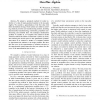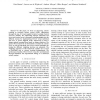CDC
2008
IEEE
15 years 19 days ago
2008
IEEE
We develop a novel localization theory for planar networks of nodes that measure each other’s relative position, i.e., we assume that nodes do not have the ability to perform me...
CDC
2008
IEEE
15 years 19 days ago
2008
IEEE
Abstract— We present a systematic method for model reduction of a class of input-quantized systems in the max-plus algebra. We consider a generalization of the flow shop with �...
CDC
2008
IEEE
15 years 19 days ago
2008
IEEE
An optimal feedback control has been obtained for linear-quadratic optimal control problems with constraints described by differential-algebraic equations. For that purpose, a ne...
CDC
2008
IEEE
15 years 19 days ago
2008
IEEE
— This paper addresses the computational overhead involved in probabilistic reachability computations for a general class of controlled stochastic hybrid systems. An approximate ...
CDC
2008
IEEE
15 years 19 days ago
2008
IEEE
— This paper addresses planning of continuous paths for mobile sensors to improve long-term forecast performance. With the information gain defined by the mutual information bet...
CDC
2008
IEEE
15 years 19 days ago
2008
IEEE
— Given an initial set of a nonlinear system with uncertain parameters and inputs, the set of states that can possibly be reached is computed. The approach is based on local line...
CDC
2008
IEEE
15 years 19 days ago
2008
IEEE
— This work presents two continuous time-varying control laws that globally uniformly asymptotically stabilize the origin of a vectorial generalization of the basic chainedform s...
CDC
2008
IEEE
15 years 19 days ago
2008
IEEE
— A wide number of mobile multi-robot systems makes use of behavior-based approaches to accomplish their missions. However, despite the advantages in term of flexibility and ver...
CDC
2008
IEEE
15 years 19 days ago
2008
IEEE
— In this paper, we focus on improving contour tracking in precision motion control (PMC) applications through the use of Cross-Coupled Iterative Learning Control (CCILC). Initia...
CDC
2008
IEEE
15 years 19 days ago
2008
IEEE
— Motivated by some crowd motion models in the presence of noise, we consider an optimal control problem governed by the Fokker-Planck equation. We sketch optimality conditions b...


